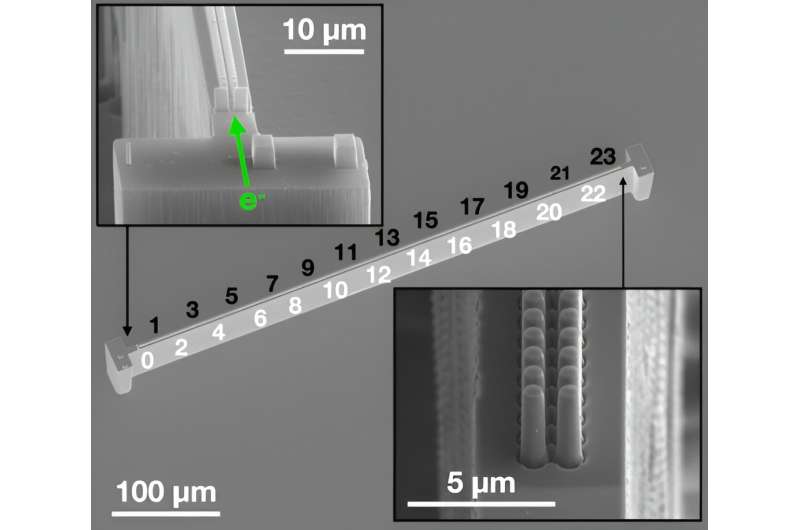This article has been reviewed according to Science X's editorial process and policies. Editors have highlighted the following attributes while ensuring the content's credibility:
fact-checked
trusted source
proofread
Accelerator-on-a-chip advance steers and accelerates electrons at the microchip scale

Stanford researchers are getting closer to building a tiny electron accelerator based on "accelerator-on-a-chip" technology with broad potential applications in studying physics as well as medical and industrial uses.
The researchers have demonstrated that a silicon dielectric laser accelerator, or DLA, can now both speed up and confine electrons, creating a focused beam of high-energy electrons. "If the electrons were microscopic cars, it's as if, for the first time, we're steering and we have our foot on the gas," said Payton Broaddus, Ph.D. '23 in electrical engineering and the lead author on a paper published in Physical Review Letters on Feb. 23 detailing the breakthrough.
Taking accelerators from miles to microns
Accelerators produce high-energy particle beams that allow physicists to study the properties of materials, produce focused probes for medical applications, and identify the elementary building blocks that make up all matter in the universe. Some of the earliest high-energy particle accelerators, developed in the 1930s, could fit on a tabletop.
But higher particle energies were required to study more advanced physics, so scientists needed to build larger systems. (Powered up in 1966, the original linear accelerator tunnel at SLAC National Accelerator Laboratory on Stanford campus is almost 2 miles long.)
While these systems have made numerous discoveries in particle physics possible, Broaddus is motivated to build a tiny linear accelerator that could eventually rival the capabilities of machines more than a thousand times its size, at a fraction of the cost.
This would also allow new applications in medicine, such as being able to attach this device to a small probe and precisely shoot an electron beam at a tumor. "There's the ability to just completely replace every other particle accelerator with something that's cheaper and smaller," he said.
Thanks to advances in nano-scale fabrication and lasers, this vision is increasingly possible, said Olav Solgaard, director of the Edward L. Ginzton Laboratory and the Robert L. and Audrey S. Hancock Professor in the School of Engineering and the senior author on the paper.
Traditional radiofrequency accelerators are made up of copper cavities that are pumped with radio waves, which give particles an energy boost. These pulses can heat up the metal, so the cavities need to operate at lower energy and pulse rates to dissipate the heat and avoid melting.
But glass and silicon structures can handle much higher energy pulses from lasers without heating up, so they can be much more powerful while also being smaller. About 10 years ago, Stanford researchers started experimenting with nano-size structures made of these materials.
In 2013, a team led by paper co-author Robert Byer, the William R. Kenan, Jr. Professor, Emeritus, demonstrated that a tiny glass accelerator with pulsing infrared light had successfully accelerated electrons. These results led to the project being adopted by the Gordon and Betty Moore Foundation under the Accelerator on a Chip (ACHIP) international collaboration to produce a shoebox-sized mega-electron-volt accelerator.
But this first "accelerator on a chip" still had some kinks to work out. As Broaddus puts it, the electrons inside were like cars on a narrow road without steering wheels. They could accelerate very quickly but just as easily crash into a wall.
Steering electrons with lasers
Now, this team of Stanford researchers has successfully shown they can also steer electrons at the nanoscale. To do this, they built a silicon structure with a sub-micron channel placed in a vacuum system. They injected electrons into one end and illuminated the structure from both sides with a shaped laser pulse that delivered kicks of kinetic energy. Periodically, the laser fields flipped between focusing and defocusing properties, which bunched the electrons together, keeping them from swerving off track.
Altogether, this chain of acceleration, defocusing, and focusing acted on the electrons for a distance of almost a millimeter. It might not sound far, but these charged particles got quite the kick, gaining 23.7 kilo-electron-volts of energy, approximately 25% greater than their starting energy. The rate of acceleration the team has been able to achieve in their prototype tiny accelerator is comparable to conventional copper accelerators, and Broaddus adds that much higher acceleration rates are possible.
While it's a significant step forward, there's more that needs to be done before these small accelerators can be used in industry, medicine, and research. So far, the team's ability to steer electrons has been limited to two dimensions; three-dimensional electron confinement will be required to allow the accelerator to be long enough for greater energy gains to occur.
Electron relay race
A sister research group at Friedrich Alexander University (FAU) at Erlangen, Germany, recently demonstrated a similar device with a single laser and starting at much lower starting energy. It and the Stanford device will ultimately be part of a kind of electron relay race, said Broaddus.
This future relay would have three teammates: The FAU device would take low-energy electrons and give them an initial kick, and then they could then be fed into a device similar to the one Broaddus is developing. The last step for the electrons would be an accelerator made of glass, like the one developed by Byer. Glass can withstand even greater pummeling by lasers than silicon, allowing the accelerator to further energize and push the electrons toward the speed of light.
Eventually, Solgaard believes such a tiny accelerator will be useful in high-energy physics, exploring the fundamental matter that makes up the universe just as its larger counterparts do. "We have a very, very long way to go," he said. But he's still optimistic, adding, "we've taken the first few steps."
More information: Payton Broaddus et al, Subrelativistic Alternating Phase Focusing Dielectric Laser Accelerators, Physical Review Letters (2024). DOI: 10.1103/PhysRevLett.132.085001
Provided by Stanford University




















